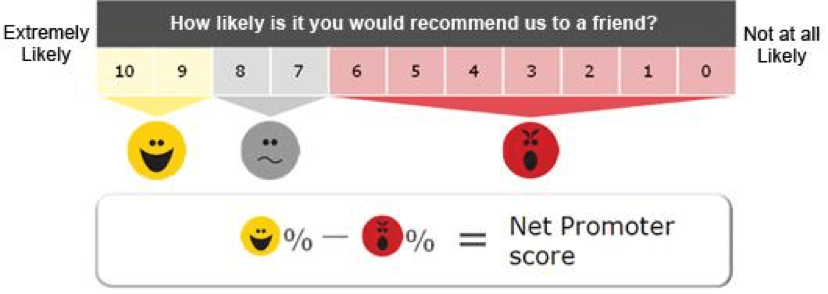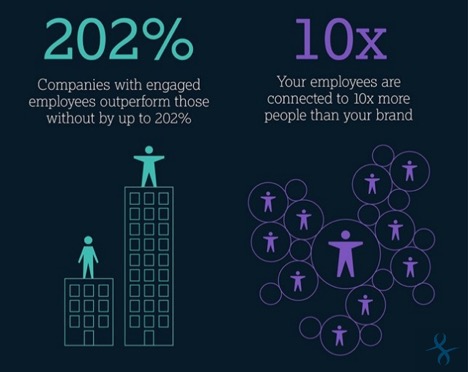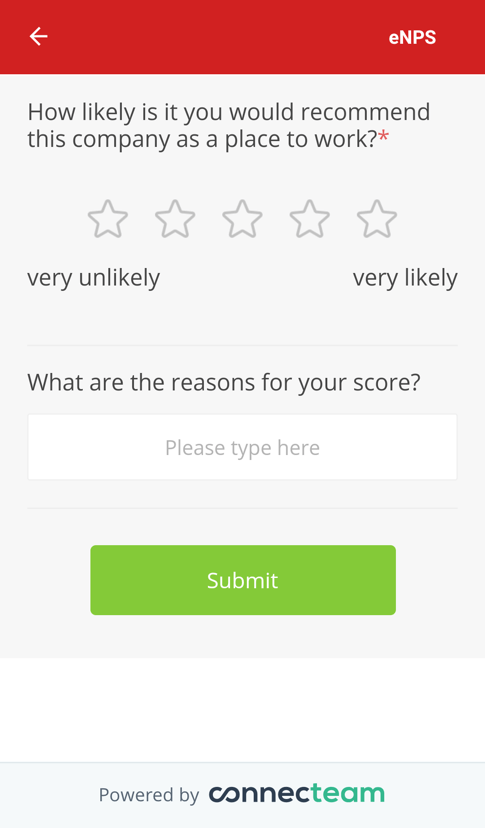There are so many different metrics and acronyms, you’re forgiven if you don’t recognize this one.
You must have noticed, though, how much the way people work is changing. As businesses struggle to keep up with customer demands and technology advances, you must rely more than ever on your key differentiator: innovative, committed, and customer-oriented people.
NPS may be the one metric you’ve never heard of that meets the speed and flexibility of the modern workforce. You’re going to be so happy you read this blog post.
Key Takeaways
- Employee Net Promoter Score (eNPS): A streamlined metric for assessing employee loyalty and engagement, crucial in fostering a committed workforce.
- Importance of Engagement: Engaged employees improve productivity, retention, and customer satisfaction, benefiting both the company and its bottom line.
- Adaptable and Flexible: eNPS works well for remote and contingent workers, offering real-time insights that cater to a flexible, mobile workforce.
- Impact of Remote Workforce: With the rise of the gig economy, engaging remote employees through eNPS and tailored tools has become essential for a cohesive company culture.
- Closing the Feedback Loop: eNPS is most effective when feedback is actively addressed, building trust and demonstrating a commitment to employee needs.
What is NPS?
Net Promoter Score® typically gauges how loyal customers are to a certain brand.
It was first introduced by Frederick Reichheld in the December 2003 issue of the Harvard Business Review’s December 2003 issue. Although it may seem overly simple, his research with Bain and Satmetrix showed that one question posed to customers often served as the strongest indicator of profitable growth:
“How likely is it that you would recommend to a friend?”
We all know by now that customer experience depends on employee experience, so it makes total sense that companies NPS as a measure for employee loyalty and engagement.
By the time Reichheld’s book published in 2011, Apple and JetBlue, innovators that they are, were already using employee Net Promoter Score (eNPS). They pioneered a new movement that serves employee loyalty with the same enthusiasm as customer loyalty.
How Do You Measure Employee NPS?
Take another pioneer, Rackspace, for example. They asked their employees after their first 90 days and on every anniversary:
“On a scale of zero to ten, how likely is it you would recommend this company as a place to work?”
Reichheld’s website shows how responses indicate three categories of employees:
 | Promoters (9-10) are so committed to your company, they want their friends to join them. |
 | Passives (7-8) are more indifferent than you may realize. |
 | Detractors (0-6) are dissatisfied. They may be speaking negatively about your company and actively looking to leave. |
The Net Promoter Score then is the percentage of employees who are promoters less the percentage of detractors. This formula accounts for the central tendency bias and focuses action on the two priorities: reduce issues and raise excellence.
The simplicity of one clear question and one meaningful score can revolutionize complex, delayed annual employee surveys the way it has cumbersome employee satisfaction surveys.
For Rackspace, eNPS provided a steady stream of feedback to identify and prioritize issues early. When low scores correlated with recruitment process feedback, they focused improvements and now employees are more likely to refer friends.
The great thing about NPS is that it’s open-source, allowing you to use and customize it for your specific organization.
For example: Enterprise uses a five-point scale. You can choose to survey every month or even more often. Some companies include a follow-up question to understand the reasons for the scores or how the company can assist the employee in reaching or keeping a 10.
Why Should You Care about Your Employee’s Loyalty and Engagement?
Companies have known the importance of employee engagement to the bottom line for decades: engaged employees are more productive, cost-effective, innovative, and of course loyal. Retention alone can save up to twice annual salary.
Gallup reports only 13% of employees worldwide and approximately 30% in the US are engaged. It’s rare but it’s worth pursuing. Those companies with engaged workforces outperformed their peers by 147% in earnings per share.
Engagement remains a hot topic in 2017 because people are more mobile and have greater expectations of meaning and growth in the workplace. 87% of employers surveyed by Future Workplace and Kronos said retention is a critical priority they are addressing with employee experience improvements like flexible work arrangements.
eNPS allows you to easily benchmark engagement across different segments, over time, and relative to competitors. Rather than complex survey data stuck in lengthy analysis at corporate headquarters, this is a metric designed for frontline teams to prioritize issues and act.
The cherry on top: it links employee NPS with customer NPS, connecting employee engagement directly with business objectives.
What Does This Have to Do with Remote Workers?
So far, for most HR execs, the above is not knocking you off your ergonomic chairs.
Enter the Gig Economy.
Two leading economists showed an increase of nearly 50% over the past decade in “alternative work arrangements.” McKinsey & Company reports 20-30% of the workforce in the US and Europe work to some degree in the gig economy and that is expected to keep growing.
Independent/contingent/gig workers include part-time carpenters, semi-retired consultants, and voiceover artists from the other side of the world. They are often more specialized, more agile, more results-oriented, and more economical.
Over 36% of the global workforce, that’s over 1.2 billion employees, considered mobile employees. GlobalWorkplaceAnalytics.com calculates American businesses save $11,000 per remote worker per year and they are just as productive as regular employees with technology available these days.
Regulations are still catching up to determine benefits and protections, as well as safety and taxation, for remote and contingent workers. Organizations likewise must prepare for a future with more of these alternative work arrangements.
The big challenge is engaging remote workers. The principles and benefits of employee engagement apply to people with any employment contract, but physical distance can impede connection with company culture and values.
So, if NPS was important to measure before, it becomes critical as the remote and contingent workforce grows.
How Can You Engage a Remote Workforce?
First, if you’re not measuring employee NPS – start. With even less opportunity for check-ins “in real life,” a regular, simple, meaningful survey is an even greater priority.
New problems require new solutions.
With most employees owning smartphones, they are used to connecting with peers instantly and voicing their opinions to brands directly, all from the toilet seat.
Lucky for employers of any size, there’s an app for that.
There is in fact a customizable, branded app that allows you to easily send all employees the NPS rating question and an open-ended question for elaboration.
And just to make it extra actionable, you can review responses in real-time; segment by location and function; and, export to Excel for analysis.
Surveys through your Connecteam employee app are simple and direct – a perfect fit with NPS.
Oh, and you can also use it for punch clocks, training, chats and all that. eNPS is seamlessly integrated with employee communications no matter when, where, or how your employees work.
Of course, Frederick Reichheld will be the first to tell you NPS only works when you “close the loop.” Whether it’s a direct conversation to address concerns or an organization-wide change, do something. The worst thing you can do is request feedback and then ignore it.
Engaging your remote workforce means you need to communicate with them in a more flexible way than you would your traditional workforce. Working remotely is all about speed and flexibility – both from necessity and preference – so you need to be able to adjust and move with your employees.
That’s why employee apps make for the perfect solution to engaging your remote workers.
Best Practices for Closing the eNPS Feedback Loop
Closing the eNPS feedback loop is essential to fostering trust and encouraging continued engagement from employees. Here are some best practices to ensure feedback is addressed effectively:
- Acknowledge All Feedback Quickly: Let employees know that their feedback is valued by acknowledging it promptly, even before solutions are in place. A simple message like “Thank you for your feedback; we’re reviewing responses and will be taking action soon” can go a long way.
- Identify Key Themes and Prioritize: Rather than addressing individual responses one by one, look for overarching themes in the feedback. If multiple employees mention workload or communication, prioritize these issues and focus on changes that can make the greatest impact.
- Communicate the Plan of Action: Share a high-level plan detailing the steps you’re taking to address the feedback. For example, if employees highlighted a lack of professional development opportunities, communicate what specific programs or workshops will be implemented.
- Involve Employees in Solutions: Create task forces or focus groups involving employees who provided feedback, especially detractors. This inclusion empowers employees, showing them that their insights help shape solutions and that they have an active role in driving improvements.
- Track and Share Progress: Regularly update employees on the progress of the changes being made, using internal newsletters, meetings, or emails. Transparency builds trust and reassures employees that their input is driving real change.
- Follow Up with Detractors and Promoters: Reach out personally to employees who scored lower (detractors) to understand their pain points in greater detail. Similarly, ask promoters what they find most satisfying about the workplace to reinforce those positive aspects and share them across the company.
- Evaluate and Iterate: After implementing changes, continue to measure the eNPS score and compare results over time. Adjust initiatives based on new feedback, keeping the improvement process dynamic and responsive.
eNPS vs. Traditional Employee Surveys
eNPS (Employee Net Promoter Score) and traditional employee surveys both aim to gauge employee satisfaction and engagement, but they differ significantly in approach, complexity, and impact on actionable insights.
Simplicity and Speed
- eNPS: Centers on a single, straightforward question – “How likely are you to recommend this company as a place to work?” – scored from 0 to 10. This simplicity allows for quick, frequent surveying and rapid analysis.
- Traditional Surveys: Often consist of multiple questions covering a range of topics, which can be time-consuming for employees to complete and for HR to analyze.
Frequency and Agility
- eNPS: Designed for regular (monthly, quarterly) check-ins, providing ongoing insights that enable HR and management to react swiftly to changes in employee sentiment.
- Traditional Surveys: Typically conducted annually or semi-annually, making them less agile in capturing shifts in employee morale and engagement over time.
Actionability
- eNPS: Due to its frequent and focused nature, eNPS results are easier to interpret and act on, providing clear metrics on employee promoters, passives, and detractors.
- Traditional Surveys: With more questions, analysis can become complex, leading to insights that may not be immediately actionable, delaying response times and undermining employee trust in the process.
Employee Experience and Engagement
- eNPS: With just one primary question and sometimes a follow-up for additional insights, employees are more likely to participate, enhancing the survey’s reach and reliability.
- Traditional Surveys: Longer formats may lead to survey fatigue, resulting in lower participation rates and potentially skewed data from only the most engaged or disengaged employees.
Benchmarking and Comparability
- eNPS: Results can be easily benchmarked over time and compared across teams or departments, providing clarity on engagement trends within the organization.
- Traditional Surveys: While valuable for deep insights, results can be challenging to benchmark and track over time due to varied survey questions and formats.
Conclusion
In today’s rapidly evolving workplace, employee engagement and satisfaction are more than just nice-to-haves; they’re essential pillars of success.
By using the Employee Net Promoter Score (eNPS), companies can gain real-time, actionable insights into employee sentiment, helping drive loyalty and productivity in ways traditional surveys often can’t.
This becomes even more critical as remote and contingent workers increasingly make up a significant portion of the workforce.
With tools like branded employee apps, companies can stay connected, close feedback loops, and ensure a supportive culture, no matter where their employees are.
Adopting eNPS as part of a holistic engagement strategy not only uplifts employee experience but also aligns directly with business objectives, proving that when employees thrive, so does the company.



